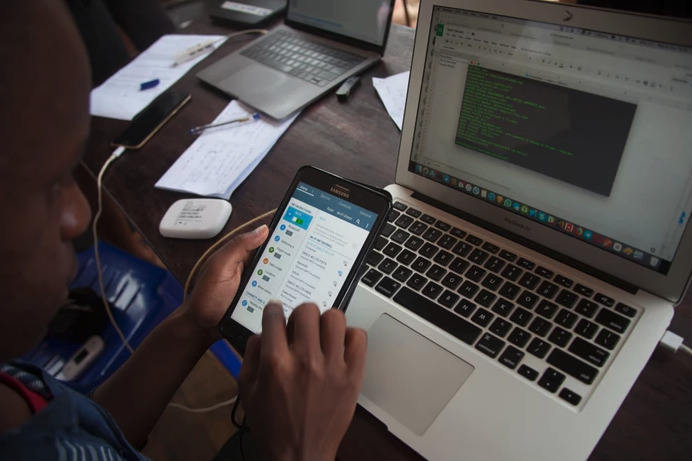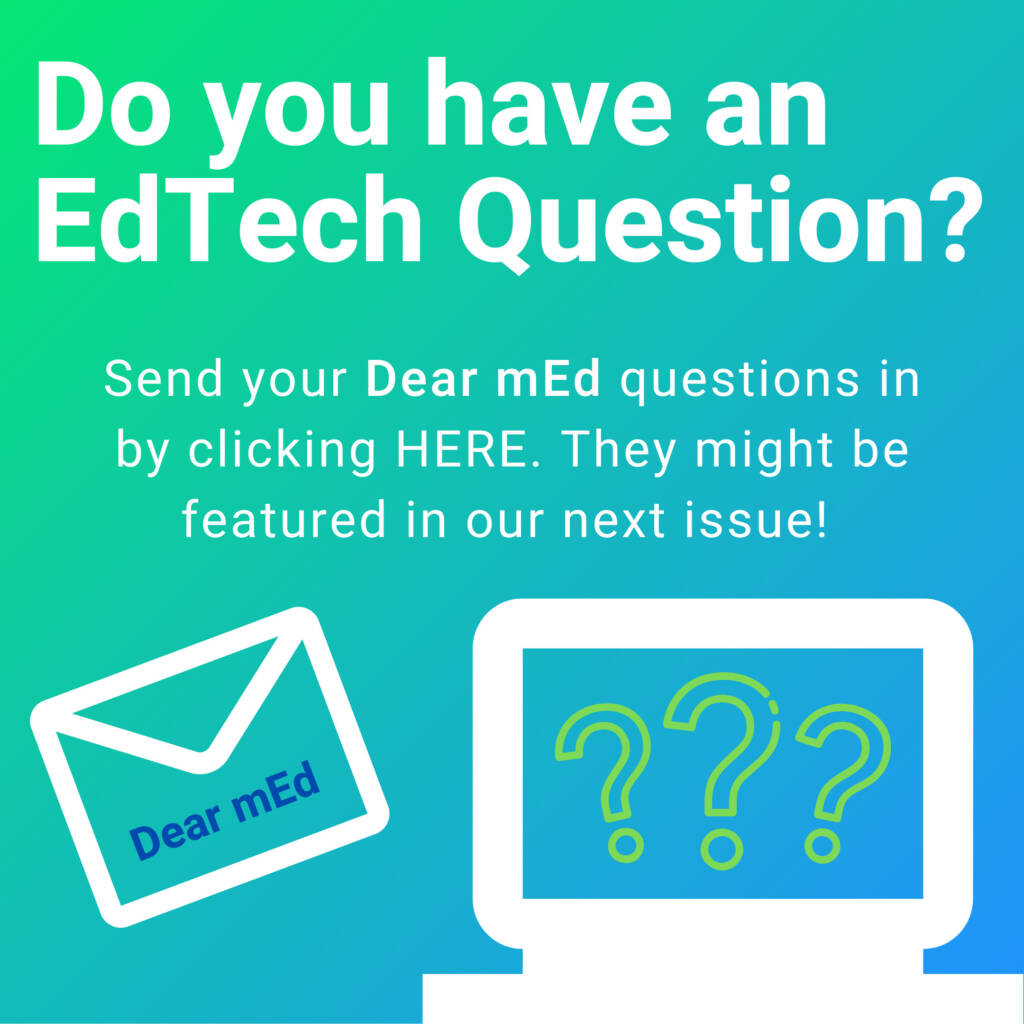Dear mEd

Question: What does the “m” in the mEducation Alliance represent?
Answer: The “m” in “mEducation Alliance” stands for “mobile” as in “mobile technologies”; however, the Alliance is interested in and supportive of a broader range of information and communication technologies (ICTs) beyond simply those used in cellular/mobile networks. For example, this would include desktop and laptop computers, tablets, radio, audio, television, video, flash drives, micro-projectors, and assistive technologies among other technologies.
Question: What activities does the Alliance support in the space of inclusive education, particularly in light of COVID-19?
Answer: All members of the Alliance are deeply committed to supporting learners with disabilities, which is shown through their activities. At our recent Play Every Day Symposia event, we had a track on Games and Play for Inclusive Education. In one of our recent e-news, we referenced several inclusive education focused activities. In this same eNews, there was reference to GSMA’s Innovation Fund for Assistive Tech and that with USAID’s support the Global Reading Network released a publication on Using Information and Communications Technologies (ICT) to Implement Universal Design for Learning (UDL) (September 2020). Over the last few months, the World Bank convened a Global Seminar on Leveraging Lessons from the COVID-19 Crisis for Learners with Disabilities (July 2020), UNESCO and INEE organized a webinar on Ensuring Inclusive Education during COVID-19 (May 2020), and the All Children Reading Grand Challenge for Development partners launched and recently closed the UnrestrICTed Challenge focused on language, literacy, and learning support for learners with disabilities grounded in Universal Design for Learning (UDL) at home and at school.
Question: What were 2-3 of your favorite, but non-traditional, presenters/presentations from your September 14-16th Play Every Day Symposia event?
Answer: Because Play Every Day included a broad range of education game developers, practitioners, and researchers, it was exciting to hear from many presenters who spoke about their work with non-tech educational games. In our Game Development in Low-Resource Settings track, Scott Nicholson, Professor and Director, Game Design and Development Organization at Wilfrid Laurier University presented on “No Room for Escape Rooms? Different Formats for Educational Escape Games in the Classroom”. In the session track on Play-Based Learning for Math and Science, Nikhil Gehlot, Director at Ideaforage Innovations Private Ltd., presented on “Trigonik: World’s First Trigonometry Based Educational Board Game”.
Question: How can the mEducation Alliance’s work help respond to the effects of the COVID-19 pandemic?
Answer: One of the mEducation Alliance’s responses included the creation of an COVID-19 EdTech Idea Call. From May to September 2020, the EdTech Hub, Global Innovation Exchange, mEducation Alliance, and UNHCR organized COVID-19 EdTech Idea Call Pitch Days to feature high-ranked applicants from the Idea Call launched in April. Along with the Pitch Days, the mEducation Alliance has also collected COVID-19 ICT4E Resources and shared promising practices through various eNews campaigns. Even the 2020 mEducation Alliance Virtual Symposia Series were based on themes addressing the continuity of learning during the pandemic.
Answers from our guest contributor

The EdTech Hub is a global non-profit research partnership. Our goal is to empower people making decisions about technology in education. We take a problem-first, rather than technology-driven, approach. Since the onset of COVID-19, the Hub has supported global responses to provide educational continuity through research, implementation support, advisory support and technical assistance in partnership with country governments.
Our “Helpdesk” service is the way we provide discrete advisory support to country partners. Two questions that we have frequently received from education decision-makers on how to effectively respond to COVID-19 are:
- How do we reach marginalized learners during COVID-19?
- What are some good practices to support teachers to carry out remote learning?
Below we summarize key considerations in response to these two questions, with links to the full responses we have produced. While these lessons largely emerged from the coronavirus context, they will have continued relevance as decision-makers shift their thinking from short-term COVID-19 response to long-term system strengthening.
Question: How do we reach marginalized learners during COVID-19?
Answer: Marginalized learners encompass girls, refugees, students with special educational needs or disabilities (SEND), students from low-income backgrounds, those in rural and remote areas that may not have access to internet or high-tech platforms, and others. ‘Reaching marginalised learners’ is simple to state but difficult to implement, as it varies greatly depending on the local context.
We recommend an evidence-based, multi-modal approach with a focus on low-tech, offline, and even paper-based initiatives. Designing an inclusive strategy requires collecting available education data that will inform the development of a multi-modal approach. Research suggests that EdTech programmes are more successful if they consider what digital infrastructure already exists, and how it could be put to better use. Important categories for consideration include device and internet availability and existing digital infrastructure (e.g., radio or TV channels, learning management systems). It is also important to remember that technology on its own – without support, training, and integration with existing systems – has not been shown to raise learning outcomes.
For more information, you can check out EdTech Hub’s suggested five part education response to Covid-19. We also have additional resources on:
- using data to inform education decisions (see questions 1 & 2),
- building effective COVID-19 education response plans,
- reaching girls and supporting gender equity through EdTech,
- reviewing the evidence on EdTech for girls’ education,
- using EdTech in fragile, conflict, and violence-affected settings,
- using EdTech for refugee education,
- using EdTech to support learners with SEND,
- providing distance learning to deaf children and
- providing distance learning to those living in rural areas and urban slums in Pakistan
Additionally, the EdTech Hub Innovation team has identified and are now supporting four promising interventions focused on addressing the education challenges created by COVID-19 school closures through Sandboxes. These were selected from the co-hosted COVID-19 EdTech Idea Call.
Question: What are some good practices to support teachers to carry out remote learning?
Answer: There is significant evidence that teaching quality is one of the most significant determinants of learning outcomes in low- and middle-income countries. We know that teachers who are equipped with good pedagogical practices are crucial to engaging students in learning while schools are closed. Given that remote learning can impact the ability of teachers to be heavily engaged in learning, the role of non-formal educators – such as parents and caregivers or community-based teachers – has risen since mass school closures.
In a traditional classroom setting, effective teacher practices include well-structured lessons with frequent checks for understanding, and adaptation to the needs of individual learners. Students benefit from high levels of interaction with teachers (a sense of ‘teacher presence’) and a sense of community. Efforts to support educators to carry out remote learning should aim to foster these same practices. For example, radio programmes can prompt interaction between siblings listening together, or promote the idea of a listener community by inviting individuals to submit questions via SMS.
Educators also need curriculum-aligned and contextually appropriate materials to support children’s learning at a distance. Given that this is a time-intensive effort, materials should be developed in partnership with schools and governments. When possible, we recommend content curation over creation. Open Educational Resources (OER) are open-source, freely available materials that can be modified and shared with others. OER have proven to be especially useful as teaching materials; they have potential to provide high-quality resources that can be adjusted to address the local circumstances.
For more information, check out EdTech Hub’s list of teacher education initiatives implemented in low-connectivity settings, many of which use OER. Stay tuned for a new resource on characteristics of effective teacher education (and EdTech-enabled examples) soon to be published. We also have additional resources on:


